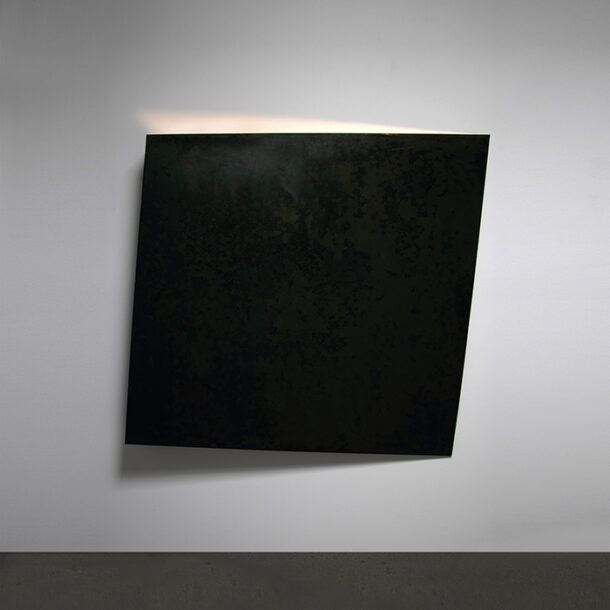
When you open the door and enter the gallery – pause. Close your eyes, feel your feet on the floor (concrete), sense the space around you with your other senses (ears, skin, proprioception). Take a breath so that you can feel your own three-dimensional self in the three-dimensional space.
Now … open your eyes and let Constance DeJong take you, step by step, view by view, on a journey.
Each piece in the new exhibition SEQUENCE has been curated carefully, placed, and organized to provide an experience that explores human perception. The exhibition invites the viewer in the gallery to engage with DeJong’s art in a particular sequence, an experiential voyage of small and large differences, of revelations and puzzles, of centering and flight, and to notice their own noticing along the way.
The viewer is first guided between two sets of square metal wall sculptures. Along the left are the large, 4-foot squares of copper – chemically patinaed deep, roiling black on the surface, each with a progressively (and mathematically proportionate) larger fold that allows the viewer to see the wall-glowing, fire-like shine of the copper verso. The fold levers the piece from 1 inch to 5 inches from the wall, canting the square respectively. The progression allows the viewer to notice the very subtle shifts of the folded pieces. Once noticing the shifts, the viewer can then take note of how those shifts affect their response, their experience of the piece.
On the opposing wall are tiny 4-inch versions of the metal pieces, formed to the same specifications. The counterpoint of the large and small pieces in line across from each other highlights the very different responses that the human body has to large format and small format works. The large Squares, with their painterly, tactile, and mysterious black surfaces, elicit a feeling of falling into. They tug at something in the solar plexus, pulling us into their dark and brooding depths, while distractions, tangled thoughts, concerns, die away, left behind as we settle quite fully into a state of presence with the work. A profound sort of quiet takes over here. In contrast, the small squares spark something bright and happy under the breastbone. These small pieces focus our attention in a gentle, glancing way.
As the viewer moves into the larger gallery space, the eye is drawn to two black metal wall-mounted columns. They are identical – with an irregular shape. By mounting the two pieces near each other, the viewer is given the opportunity to see both sides of the piece at the same time. Whereas normally one would need to work round each side to view the differences in the forms – here the identical companion piece shows the viewer what they can expect on the far side. It’s a bit like magic and highlights another aspect of human perception. Whereas the first set of pieces contrasted scale and illuminated the subtle shifts of angle – this installation allows the viewer to explore the ideas of three-dimensional space, of back and front, of the limitations of our sight.
Finally, the viewer comes to a series of new drawings from a series titled Score. These exquisite puzzles demand the viewer lean in close to examine their intricate lines and shapes. The complex drawings are “generated” using the principles of the Golden Mean. Once DeJong has made her first set of lines – the rest of the piece unfolds from this starting point according to mathematical principles. The drawings are, in some ways, like a microcosm of the exhibition at large. While the installation of the exhibition was created to draw the viewer in through a series of shifts in perception – the drawings themselves do this same work on the small scale. They draw the viewer’s eye through a sequence of moves and shapes as the puzzle progresses and becomes both more complex and more comprehended as the viewer goes.
In the end, the exhibition as a whole does what DeJong’s work, piece by piece, is always so good at doing: it assists the viewer in landing firmly in the present moment. Distractions fall away. With their dark depths and bright flares of light, the pieces vibrate with a kind of presence that translates itself into the viewer. The viewer is lured, step by step, into a state of quiet concentration. We stay with the work, in the work. Solid. Grounded. Here. Now.

